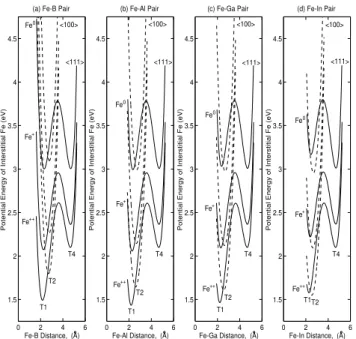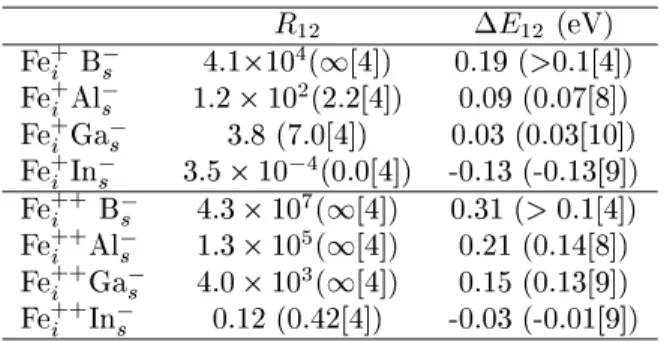Struture and Bonding of Iron-Aeptor Pairs in Silion
S.Zhao,
TexasInstrumentsIn.,Dallas,TX,75243
J. F. Justo, L. V. C. Assali,
InstitutodeFsia,Universidade deS~aoPaulo,
CP66318, CEP05315-970, S~aoPaulo,SP,Brazil
and L.C. Kimerling
Massahusetts InstituteofTehnology,Cambridge,MA,02139
Reeivedon23April,2001
Iron-aeptor pairs (Fe-A, A = B, Al, Ga, and In) in silion were investigated using an
ioni-basedmodel,whihinorporatesthevaleneeletronloudpolarizationandthelattierelaxation.
Our results are generaly ingoodagreement withthe experimental trendsamongthe Fe-A pairs,
desribingtheinreaseinthepairdonorenergylevelwithinreasingAprinipalquantumnumber
anddereasingpairseparationdistane,andthepairongurationalsymmetries.
Iron pairs with aeptor impurities in silion [1℄,
forming eletrially ative enters. The properties of
these pairs, suh as the ongurational struture and
thepositionsoftheenergylevelsinthebandgap,have
beeninvestigated by eletron paramagneti resonane
(EPR)anddeepleveltransientspetrosopy(DLTS)[2℄
overthelastthirtyyears. Thesepairshavebeen
identi-edasonsistingofasubstitutionalaeptor(A
s )with
aniron(Fe
i
)ateither thenearestneighbor(T1,h111i
symmetry)orthenextnearestneighbor(T2,h100i
sym-metry) tetrahedral interstitial site. Aording to an
ionimodel,usedtoexplaintheexperimentaldata,the
Fe
i A
s
pairsareformedbyapositivelyhargediron(Fe +
i
orFe ++
i
)andanegativelyhargedaeptor(A
s ).
The ioni model fails in desribing several trends
among the Fe
i A
s
pairs,suh as the pair stability and
the related positions of the aeptor and donor
ele-troni levels[3℄. Adding anelastienergyterm tothe
pointhargeinteration,Kimerlingetal. [4℄explained
thepairstruturesobservedbytheexperiments. They
notied that large aeptor impurities provide strong
repulsionenoughtoompetewiththeCoulomb
attra-tion so that the Fe
i
stays at a T2 site (and not at a
T1site) nexttotheaeptor. Ourmodelinorporates
anewinterationinthepointhargeCoulomb
intera-tion,ashortrangeattrativeomponenttosimulatethe
valeneeletroniloudpolarization[5℄. Therepulsive
interation between Fe
i and A
s
orSi is approximated
by a softened Lennard-Jones type potential, and the
silion rystal is treated as adieletri medium. The
resultsareomparedtotheexperimental dataon
on-gurationalsymmetries and deep levelpositions. Our
modelapturedseveraltrendsonthepairsobservedby
experiments[2℄,showinganinreasein thepairdonor
energylevelwithinreasingprinipalquantumnumber
ofA
s
anddereasingpairseparationdistane,opposite
toresultsobtainedbyKimerlingetal. [4℄.
WhentheseparationbetweenFe
i andA
s
is
ompa-rabletotheirioniradii,theeletroniloudofoneion
isstronglyperturbedbytheeld oftheother,ausing
an induedpolarizationon that eletroni loud. Our
polarizationmodel(PM)inludesashortrange
attra-tiveomponenttotheCoulombinterationtodesribe
the eletroni loudpolarization. As anestimation to
theinduedeletroniloudpolarizationeet,wetake
thevaleneeletroniloudasahargedspherial
sur-fae at ertainradius around theradial peak position
of thevaleneeletroni hargedensity. Then, similar
totheinterationbetweentwoondutingspheres,the
eletrostatiinterationanbewrittenas(rr
Fe A )
V
att (r)=
1
4
r
0
q
1 q
2
r 1
2
a 3
2 q
2
1
r 4
+ a
3
1 q
2
2
r 4
; (1)
wherea
1 anda
2
arethevaleneeletroniloud
spher-ialsurfaeradii,q
1 andq
2
arethenetioniharges.
Thealulationswereperformedusing279Siatoms,
one A
s
, and one Fe
i
. The distane r
Fe A
is hanged
alongh111idiretion(passingthroughT1andT4sites)
andh100idiretion(passingthroughT2site)tondthe
potentialurvesforFe 0
i ,Fe
+
i
,andFe ++
i
. Theminimum
ofeahurveV
min (Fe
0
i ),V
min (Fe
+
i
),andV
min (Fe
++
i )is
theground stateforFe 0
i , Fe
+
i
,and Fe ++
i
, respetively.
ThemodelpreditstheFe
i A
s
pairongurational
sym-metriesbydeterminingtheenergetiallyfavorablesites
0
2
4
6
1.5
2
2.5
3
3.5
4
4.5
(a) Fe-B Pair
Potential Energy of Interstitial Fe (eV)
Fe-B Distance, (A)
0
2
4
6
1.5
2
2.5
3
3.5
4
4.5
(b) Fe-Al Pair
Fe-Al Distance, (A)
Potential Energy of Interstitial Fe (eV)
0
2
4
6
1.5
2
2.5
3
3.5
4
4.5
(c) Fe-Ga Pair
Fe-Ga Distance, (A)
Potential Energy of Interstitial Fe (eV)
0
2
4
6
1.5
2
2.5
3
3.5
4
4.5
(d) Fe-In Pair
Fe-In Distance, (A)
Potential Energy of Interstitial Fe (eV)
Fe
Fe
Fe
<111>
<100>
<111>
<100>
<111>
<100>
<111>
<100>
T1
T2
T4
T1
T2
T4
T1
T2
T4
T1
T2
T4
0
+
++
Fe
Fe
Fe
0
+
++
Fe
Fe
Fe
0
+
++
Fe
Fe
Fe
0
+
++
Figure 1. Therole of Fei harge state onthe FeiAs pair
symmetry and stability. Thepotential urvesalong h111i
and h100i diretions are represented by solid and dashed
lines,respetively.
Fig. 1showsthe potential urves alongh111i and
h100i diretions for Fe 0
i , Fe
+
i
andFe ++
i
. Aordingto
Figs. 1a and 1d, stable Fe
i B
s
and metastable Fe
i In
s
pairshaveh111i-trigonalsymmetry,whilestableFe
i In
s
and metastable Fe
i B
s
pairs have h100i-orthorhombi
symmetry. The h111i-trigonal symmetry an be
as-signed to stable Fe +
i Al
s , Fe
++
i Al
s , Fe
+
i Ga
s , and
Fe ++
i Ga
s
pairs, while metastable Fe +
i Al
s , Fe
++
i Al
s ,
Fe +
i Ga
s
, and Fe ++
i Ga
s
pairs show h100i symmetry
(Figs. 1band1). Inaddition,Figs. 1band1predit
that thestable Fe 0
i Ga
s
pair exhibits h100i symmetry,
while the stable Fe 0
i Al
s
pair has equal probability to
showeitherh111i-trigonalorh100i-orthorhombi
stru-tures. Theassignmentsforstableandmetastable
stru-turesare in good agreement withtheEPRand DLTS
observations[2℄. Thestableongurationswithesfrom
h111i-trigonaltoh100i-orthorhombiforFe
i A
s
pairs
go-ing from B
s to In
s
, and is related to an inrease in
repulsionbetweenA
s andFe
i .
The minimum of eah urve an be used to
om-pute the pair aeptor and donor levels. For Fe
i at
near neighbor T sites relative to A
s
, the donor level
(Fe +=++
i A
s )
0=+
isgivenby
E
T
(0=+)=E
v +V
min (Fe
+
i ) V
min (Fe
++
i )+E
0
T ; (2)
where E
v
isthetopofthevalenebandandE 0
T isthe
minimumoftheFe ++
i
potentialurveatnearneighbor
sitesofA
s
. Thepairaeptorlevel(Fe 0=+
i A
s )
=0
is
ob-tainedbyaddingthediereneV
min (Fe
0
i )-V
min (Fe
+
i )to
thedonorlevel. ForisolatedFe
i
,atremotesitesrelative
to A
s ,V
min (Fe
0
i )-V
min (Fe
+
i
)=0.38eV, whih is onsis-Fe
0=+
i
at E
v
+0:38eV exists in theband gap. Inour
model,thedierenebetweenV
min (Fe
0
i )andV
min (Fe
+
i )
forisolatedFe
i
arisesfromtheelastienergyausedby
eletronshelloverlapbetweenatoms. Fig. 2showsthe
donor(0/+)andaeptor(-/0)levelsforthetransitions
asomputedby ourpolarization model forFe
i sitting
atT1 (Fig. 2a)orT2 (Fig. 2b)sites. Our resultsfor
thepairdonorandaeptorlevelsagreeverywellwith
theknown experimental data for the (0/+) and (-/0)
transitions.
ThePMpreditstheorretmagnitudesandtrends
of thedonorlevelfor the T1 site (E
T
(1)) and theT2
site(E
T
(2))pairswithinreasingA
s
sizeand
dereas-ingr
Fe A
as observedin experiments, whilethe point
harge model would give an opposite trend.
Aord-ing to our model, repulsion and polarization from A
s
shouldgiveamaximumontributionattheT1siteand
yield the greatest variation in Fe
i A
s
pair energy
lev-els. Thisisonsistentwiththeexperimentaldatathat
E
T
(1) displays the greatest sensitivity to A
s
identity
andE
T
(2)showsrelativeuniformity. ThePMsuggests
that the pair aeptor level (Fe 0=+
i A
s )
=0
should
be-omeshallowerintheband gapasA
s
goesfromB
s to
In
s
,whilereentexperimentaldata[6℄suggestthatthis
levelisalmostonstantforA
s .
(a)
VB
CB
Fe B
i s
Fe Al
i
s
Fe Ga
i
s
Fe In
i
s
(b)
VB
CB
Fe B
i s
Fe Al
i
s
Fe Ga
i
s
Fe In
i
s
Figure2. Representationofdonorandaeptorlevels,
or-respondingto(0/+) and(-/0) transitions,for FeiAs. The
gureshows the levels for the Fei sitting at a T1 site(a)
andat aT2 site(b). Dashed linesrepresent theavailable
Table I. Pair binding energies E
b
(in eV), omputed
using the polarization model, for stable Fe
i A
s in Si,
omparedtoexperimental data.
Fe
i A
s
E exp
b
E
b
Fe +
i B
s
0.65[3℄, 0.58[7℄ 0.56
Fe +
i Al
s
0.52[8℄ 0.58
Fe +
i Ga
s
0.53
Fe +
i In
s
0.55
Fe ++
i B
s
1.13
Fe ++
i Al
s
1.04[8℄ 1.19
Fe ++
i Ga
s
1.16
Fe ++
i In
s
1.09
ThepairbindingenergiesareshowninTableI.The
model preditsatrendofmonotoni dereasewith
in-reasingA
s
sizefor bothFe +
i
andFe ++
i
. The inrease
inbindingenergyduetovaleneeletroniloud
polar-izationompeteswiththerepulsiveinterationso that
the model gives nearly onstant binding energies for
bothFe +
i
andFe ++
i
,onsistentwithexperimentaldata
[3,7,8℄. Lattierelaxationlearlyplaysan important
rolein determiningthepairbindingenergy.
The relativepopulationof Fe
i A
s
pairsin aertain
harge state at T1 and T2 sites (R
12
) is alulated,
basedonaBoltzmanndistributionat thermal
equilib-rium:
R
12 =
N(1)
N(2) =
Z
1
Z
2 exp
E
12
kT
; (3)
where E
12 = E
min
(T2) E
min
(T1) is the energy
dierene for Fe
i
at the T1 and T2 sites, and Z is
the site degeneray. The relative site populations for
the pairs are ompared with results from
metastabil-ityexperimentsinTableII.Ourmodelprovidesagood
desription of the energy dierenes between the T1
and T2 sites (E
12
)for all the pairs. The alulated
N(1)=N(2) ratios at T = 200 K, around the
temper-ature of the observedstrutural transformation [8,9℄,
alsoagreeverywellwiththeexperimentaldata.
TableII.Calulatedrelativesitepopulations(R
12 )atT
=200Kandenergydierene(E
12
),betweenenters
withFe
i
atT1andT2sitesforthepairs. Experimental
resultsareinparenthesis.
R
12
E
12 (eV)
Fe +
i B
s
4.110 4
(1[4℄) 0.19(>0.1[4℄)
Fe +
i Al
s
1:210 2
(2.2[4℄) 0.09(0.07[8℄)
Fe +
i Ga
s
3.8(7.0[4℄) 0.03(0.03[10℄)
Fe +
i In
s
3:510 4
(0.0[4℄) -0.13(-0.13[9℄)
Fe ++
i B
s
4:310 7
(1[4℄) 0.31(>0:1[4℄)
Fe ++
i Al
s
1:310 5
(1[4℄) 0.21(0.14[8℄)
Fe ++
i Ga
s
4:010 3
(1[4℄) 0.15(0.13[9℄)
Fe ++
i In
s
0.12(0.42[4℄) -0.03(-0.01[9℄)
In summary, our model aptures several eets
withintheionimodelframework:(i)trendsamongthe
FeA pairsrevealingadeepeningofthedonorlevelin
theband gap withinreasingprinipal quantum
num-berofA
s
anddereasingpairseparationdistaner
Fe A ;
and(ii) ongurationalsymmetriesand thebistability
ofthepairs. However,thedeviationsatE
T
(1)between
measuredandalulateddatasuggestthatother
inter-ations are still missing. The deviations ould ome
from thelimitationsoftheionimodelsatnear
neigh-bor T sites. The bulk, treated as dieletri medium,
an still be valid for the spae betweena T4 siteand
theA
s
,andbetweenaT2siteandtheA
s
. However,at
the T1 site, the sreening would hardly be eetively
desribed by thebulk dieletrionstant, sineone of
the Fe
i
rst neighbors is theA
s
. Covalenyinvolving
theFe
i ,A
s
,andsurroundingSiatomsmayalsoplayan
importantrole,aspointedoutbyrst-priniples
alu-lations[11,12,13℄. Althoughaompleteunderstanding
onthepropertiesofthepairsshouldbeestablishedwith
moredetailed experimentsandalulations,ourmodel
isimportantin identifyingtheontributionofeah
in-terationforthepairformation.
Aknowledgments
ThisworkissupportedbytheNRELunderontrat
No. XD-2-11004-4. JFJandLVCAthanktheBrazilian
ageniesFAPESPand CNPqfornanialsupport.
Referenes
[1℄ G.W.LudwigandH.H.Woodbury,SolidStatePhys.
13,223(1962).
[2℄ A. A.Istratov, H.Hieslmair, andE. R.Weber, Appl.
Phys.A69,13(1999).
[3℄ L.C.KimerlingandJ.L.Benton,Physia116B,297
(1983).
[4℄ L. C. Kimerling, M. T. Asom, J. L. Benton, P. J.
Drevinsky, and C. E. Caefer, Mater. Si. Forum
38-41,141(1989).
[5℄ S.Zhao,L.V.C.Assali,J.F.Justo,G.H.Gilmer,and
L.C.Kimerling,J.Appl.Phys.90,2744(2001).
[6℄ P. Tidlund, M. Kleverman, and H. G. Grimmeiss,
Semiond.Si.Tehnol.11,748(1996).
[7℄ W. Wijaranakula, J. Eletrohem. So. 140, 275
(1993).
[8℄ A.ChantreandD.Bois,Phys.Rev.B31,7979(1985).
[9℄ A. Chantre and L. C. Kimerling, Mater. Si. Forum
10-12,387(1986).
[10℄ H.Takahashi,M.Suezawa,andK.Sumino,Mater.Si.
Forum83-87,155(1992).
[11℄ L.V.C.AssaliandJ.R.Leite,Mater.Si.Forum
10-12,55(1986);38-41,409(1989);83-7,143(1992).
[12℄ L.V.C.AssaliandJ.F.Justo,Phys.Rev.B58,3870
(1998).
[13℄ J.F.Justo andL. V. C.Assali, Int.J.Mod.Phys.B

